The Lure of the Penny Black

Practically every stamp collector in the world would like to own a Great Britain 1840 Penny Black.
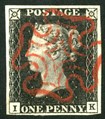 |
It doesn't matter if you collect stamps from countries from Abu Dhabi to Zululand or anything in-between. The Penny Black is the Mother (therefore perhaps the Two Pence blue is the Father!) of Postage Stamps.
However there is much more to the Lure of the Penny Black than the fact that it was the first Postage Stamp in the world, beating off other contenders for the title, such as the Greek 40 Lepta label of 1831 or the so-called Austrian 1k.of 1839.
The Penny Black was put on sale on to the public in London on Friday 1st May 1840, although it was not valid for use until Wednesday May the sixth. However, a few are known used before the sixth. These pre-Official first day usages are very greatly prized by collectors.
It is a fact, perhaps not widely appreciated, that the "labels" (the Penny Black and Two Pence Blue Postage Stamps) were considered by the authorities a somewhat poor alternative to the prepaid 1d. and 2d. envelopes and letter sheets designed by the noted artist of the day, William Mulready, R.A., which were placed on sale at the same time (but that is another story).
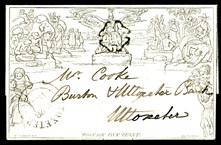 |
So what is the Lure of the Penny Black?
The design is beautifully simple and elegant with the beautiful William Wyon head of Queen Victoria and the legends "POSTAGE" at top and "ONE PENNY" at the foot, at the same time combined with an intricate engine turned background. The parallel with our current definitive stamps which are based on a plaster cast of Queen Elizabeth II by Arnold Machin is obvious.
One thing about the design which confuses many collectors is the significance of the two letters that appear in the lower corners. These are quite simply explained but of enormous importance to specialists.
The Penny Black was printed from eleven separate printing plates, each containing 240 impressions arranged in twenty horizontal rows of twelve (12 pence = One shilling, 20 shillings = £1) which was important for Post office accounting purposes.
The stamp in the upper-left corner of the sheet had the letters AA in its lower corners, the next stamp was lettered AB then AC, AD and on to AL, the first stamp in the next row was BA, etc., down to the lower-right corner of the sheet which was lettered TL (below, a strip of four showing the different letters).
 |
So we can see that each of the 240 different combinations of letters are equally rare (or as common!).
This was done as a form of protection against forgery as it was thought to be impractical for a forger to be able to reproduce 240 different combinations of lettering and it would be noticed if quantities of mail bearing stamps with the same letters were found.
Where the letters are of great significance is in helping us tell which of the 11 (or twelve, but more of that later) plates a particular stamp was printed from.
The 240 impressions in each of the 11 (or 12) plates were produced from a single Mother Die which had blank lower corners. This was rocked onto a steel plate 240 times and the corner letters were then hand-punched onto the plate. As one would expect, there are small differences in the positioning of these letters which, along with other plating aids, enables us to distinguish between the plates (below, examples from plate Ia and III, note the difference in the "B" square).
  |
The first plate (plate I) was rushed into use to meet the issue date for the stamps and was used before the steel plate had been hardened, this resulted in very rapid wear. Owing to the extreme wear, the engraved lines of the Queen's head became very faint, and this necessitated the restoration of every one of the 240 units of the plate. Therefore stamps from plate I are classified as either plate Ia (the original plate) or plate Ib (the re-entered plate).
The Penny Black and Two Pence blue immediately proved to be very popular with the public despite the fact that they had to be cut from the sheets with scissors (perforations were still 10 years or more away) and the rather uncertain glutinous wash on the back has to be licked to adhere the stamp to the letter.
The stamps were to be cancelled by a red postmark, known to collectors as the "Maltese Cross", a few of these cancellation devices were damaged or lost and replaced, resulting in what are known as "distinctive" Maltese Cross cancellations, occasionally the cancellation was applied in a different coloured ink such as blue, magenta, yellow or violet.
However, it was soon discovered that the red ink used for cancelling the black stamps could quite easily be cleaned off and there was a danger of the stamp being used again. This was definitely not what the Post Office wanted. In August 1840 it was decided to change the colour of the 1d. value from black to red, however printing of the stamps in the new colour was delayed whilst extensive experiments were conducted to find a new type of black ink for obliterating the stamps in order to prevent the removal of postmarks and re-use of the stamps. Printing of the stamps in red commenced in late December 1840 and the stamps in that colour came into use in early February 1841.
Several of the original Penny Black plates, Ib, II, V, VIII, IX, X and XI, were also employed to print the stamps in red. Interestingly, because supplies of the Black stamps were running low, additional printings were made in that colour, after the red printing had commenced. Below, plate VIII, DD printed in black and in red, a "matched" pair.
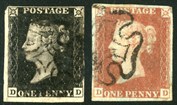 |
In total about 280,000 sheets of Penny Blacks, 63,000,000 stamps were produced, not counting another nearly 8,500 spoilt sheets printed and officially destroyed.
As was said at the beginning of this article every collector wants a Penny Black. A serious collector of Great Britain would like at least one from each plate. There are a few collectors who want to have examples from each of the 240 impressions from each of the twelve plates (That would be 2,880 Penny Blacks!).
What is a Penny Black worth?
When assessing the value of a Penny Black there are many things that must be taken into consideration:
Condition, Plate, Margins, Cancellation, etc.
In June of 2011 Spink and Son Ltd sold a single 1d. black on a cover for nearly £300,000, this was for a quite remarkable example from Plate 2, lettered TL, from the lower-right corner of the sheet with marginal inscription and Plate number. This is considered to be the finest Penny Black on cover in existence and is no indication as to the value of a normal Penny Black (below)!
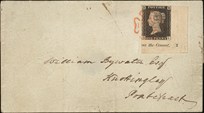 |
Let's take the various catagories above and consider them for a moment.
Condition: Thins, creases, small tears (even if not readily apparent will reduce the value considerably.
Plate: The plate is very important, the commonest plate is plate VI with a little over 9,000,000 stamps being printed. The rarest is plate XI with only 168,000 stamps (just 700 sheets) printed.
Margins: As already mentioned, the Penny black was issued imperforate, therefore the stamps had to be cut from the sheet by scissors (or occasionally torn from the sheets). The gap between the impressions is not large and so it is not surprising that the design is often cut-into, this detracts from the value enormously, the more a stamp is cut into the more the value is reduced, however bear in mind that for every stamp that was cut into when separating them there is another with an extra large margin, and this, naturally enough, enhances its value. It is not unusual for a multiple, for example a pair, where one stamp is fine with good margins but the adjoining stamp is defective or cut into, for the damaged stamp to be sacrificed leaving the fine example with an extra large margin (below, note the postmark at right, clearly a pair that has been sacrificed).
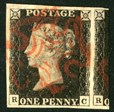 |
Cancellation: This is of course a matter of opinion. I much prefer the red Maltese Cross to the black one, a crisp, rather than overinked impression is much more pleasing to the eye, complete and upright is an advantage but most preferred is when the cancellation leaves to profile of Queen Victoria clear.
If you can get a combination of all the points above you have the final consideration -
Aesthetic appeal (below).
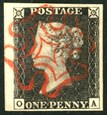 |
Here are a few tips to plating the Penny Black:
Cancellation - The red and black Maltese Cross cancellations exist on all plates but the black Maltese Cross is more likely to come on the later plates.
The "O" flaw - This is a white blob that develops on the right of the "O" of "ONE" and only occurs on plates VII, VIII, IX and X. (below, a matched pair from plate X showing the "O" flaw).
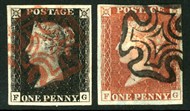 |
Shade - Plates Ia can, because of the very rapid wear of the plate, be greyish black in shade, plate XI, the rare Plate, is also often a grey-black shade (but a different grey-black), although this is due to the ink rather than plate wear (below, the grey-black of plates Ia and XI).
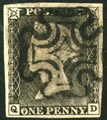 |
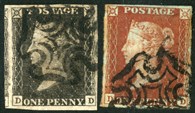 |
There are also a number of plate varieties, such as double letters, guide lines, etc. that can be of help.
However, almost always we need to go to the reference works to successfully plate a Penny Black by studying the positions of the corner letters.
I find "The Plating of the Penny Black" by Nissen and Mc Gowen the most useful guide, this magnificent opus has recently been reprinted and can be bought for between £70-£80 and is invaluable if you are to specialise in this beautiful stamp. Another useful book is "Guide Lines to the Penny Black" by P.C. Litchfield, this can be picked up for around £10 and although helpful, it is not, in my opinion, as good as the "Plating of the Penny Black".
Taking all the points above into consideration, the best tip I can give for plating a Penny Black is to take a quick look at the back of the stamp, there will often be a pencilled plate number written by a previous owner! They may not always be 100% accurate but it's a good starting point.
Perhaps the "Lure of the Penny Black" is attempting to find with larger margins, a crisper cancellation and more aesthetic appeal than the one you already own.
Happy Collecting!



